1994 CADILLAC FLEETWOOD automatic transmission
[x] Cancel search: automatic transmissionPage 105 of 398
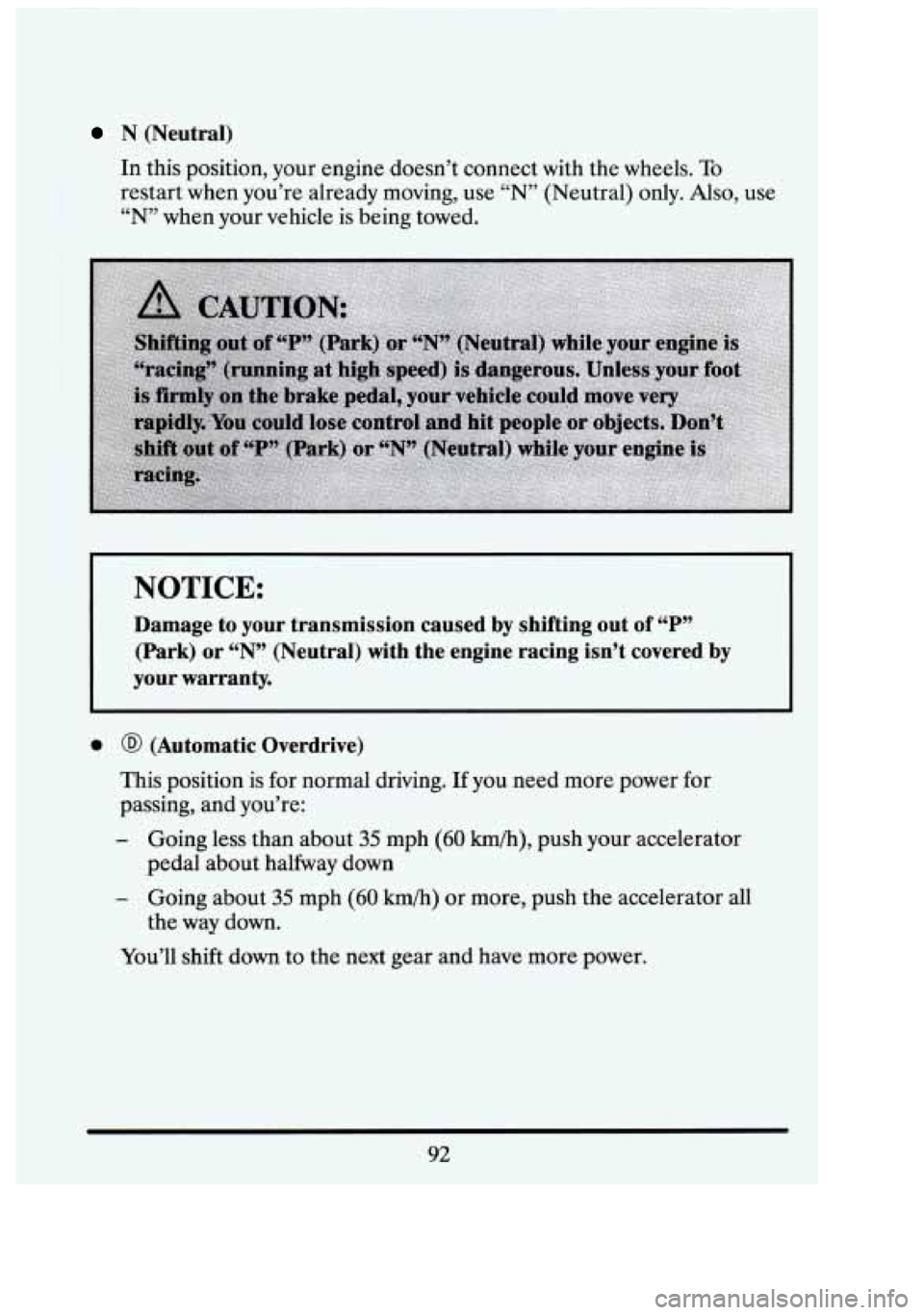
I
A
N (Neutral)
In this position, your engine doesn’t connect with the wheels. To
restart when you’re already moving, use “N” (Neutral) only. Also, use
“N” when your vehicle is being towed.
NOTICE:
Damage to your transmission caused by shifting out of “P”
(Park)
or “N” (Neutral) with the engine racing isn’t covered by
your warranty.
0 @ (Automatic Overdrive)
This position is for normal driving. If you need more power for
passing, and you’re:
- Going less than about 35 mph (60 km/h), push your accelerator
- Going about 35 mph (60 h/h) or more, push the accelerator all
pedal about
halfway down
the way down.
You’ll shift down to the next gear and have more power.
7’ P
I
1
92
Page 111 of 398
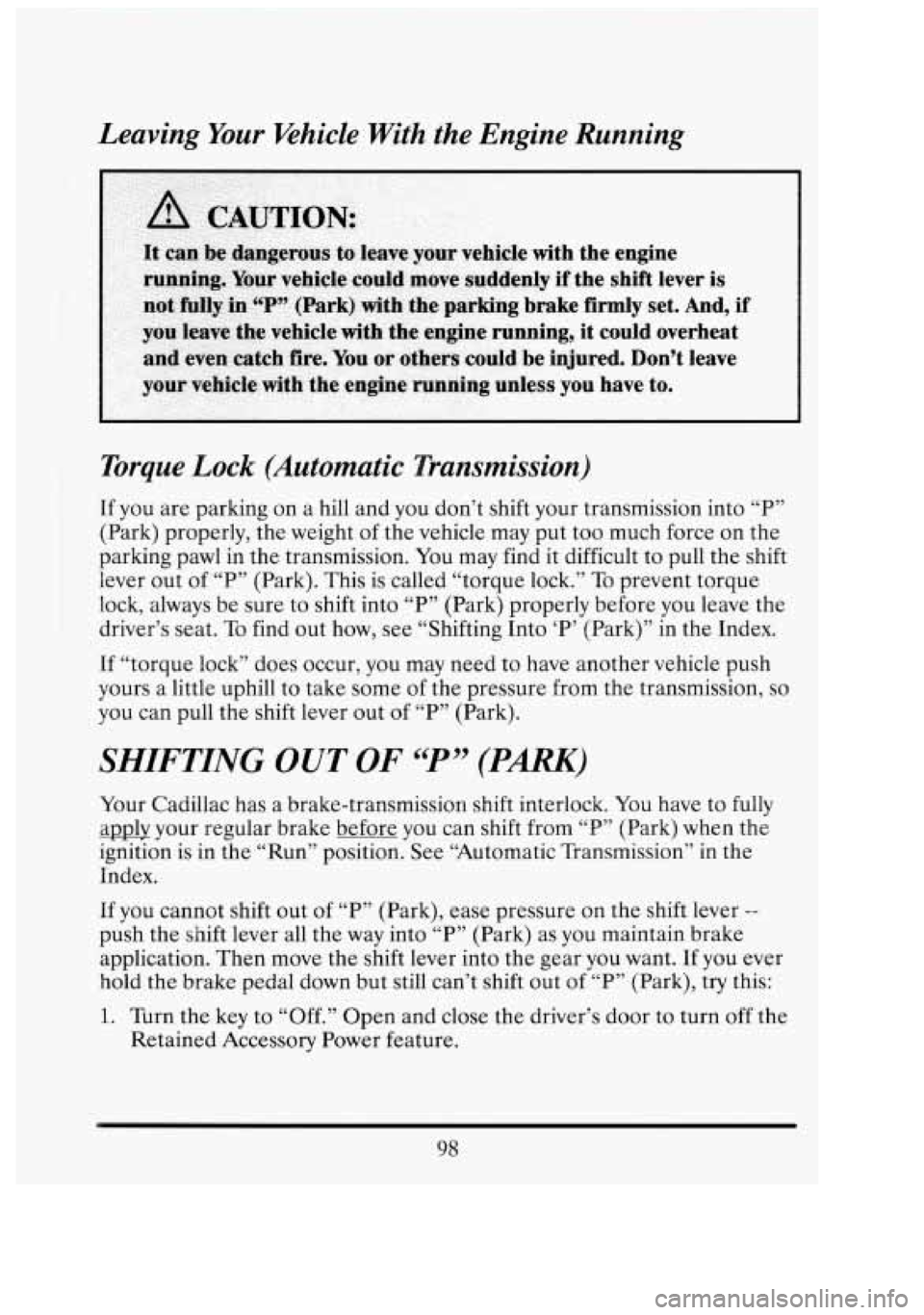
having Your Vehicle With the Engine Running
Torque Lock (Automatic Transmission)
If you are parking on a hill and you don’t shift your transmission into “P”
(Park) properly, the weight of the vehicle may put too much force
on the
parking pawl in the transmission.
You may find it difficult to pull the shift
lever out
of “P” (Park). This is called “torque lock.” To prevent torque
lock, always be sure to shift into “P” (Park) properly before you leave the
driver’s seat.
To find out how, see “Shifting Into ‘P’ (Park)” in the Index.
If “torque lock” does occur, you may need to have another vehicle push
yours a little uphill to take some of the pressure from the transmission,
so
you can pull the shift lever out of “P” (Park).
SHIFTING OUT OF “P” (PARK)
Your Cadillac has a brake-transmission shift interlock. You have to fully
apply your regular brake before you can shift from
“P” (Park) when the
ignition is in the “Run” position. See “Automatic Transmission”
in the
Index.
If you cannot shift out of “P” (Park), ease pressure on the shift lever --
push the shift lever all the way into “P” (Park) as you maintain brake
application. Then move the shift lever into the gear you want.
If you ever
hold the brake pedal down but still can’t shift out of “P” (Park), try this:
1. Turn the key to “Off.” Open and close the driver’s door to turn off the
Retained Accessory Power feature.
3
r
b 4
Ir
Eli
I
98
Page 131 of 398

If you cover the sensor, it will sense that it is dark outside and your lights
will come on.
Cornering Lights
If your exterior lights are on, the cornering lights will come on when you
signal a turn. This will provide more light for cornering when its dark.
Underhood Light
Your vehicle has a Delay Interior Lighting System (DIL). This system
controls power to the underhood light. Just pull up on the door handle
,with the hood raised and the lamp will light for about
10 minutes.
Every time the door handle is pulled up the light will stay on another
10 minutes. The light will go off when you close the hood.
Daytime Running Lights (Canada Only)
The Canadian Federal Government has decided that “Daytime Running
Lights’’ (DRL) are a useful feature, in that DRL can make your vehicle
more visible to pedestrians and other drivers during daylight hours. DRL
are required on new vehicles sold in Canada.
Your DRL work with a light sensor on top of the instrument panel. Don’t
cover it up.
The high beam headlights will come on at reduced brightness in daylight
when:
0 The ignition is on
0 The headlight switch is off, and
The transmission is not in “P” (Park).
At dusk, the DRL will switch
off and the exterior lights will come on
automatically. At dawn, the exterior lights will go out and the high beams
will change to the reduced brightness of DRL (if the headlight switch is
Of course, you may still turn
on the headlights any time you need to.
To idle your vehicle with the DRL off, shift the transmission into “P”
(Park), turn the ignition OFF, and then restart your engine. The DRL will
stay off until you shift out of “P” (Park).
off).
01
I
l
I
i
118
Page 224 of 398
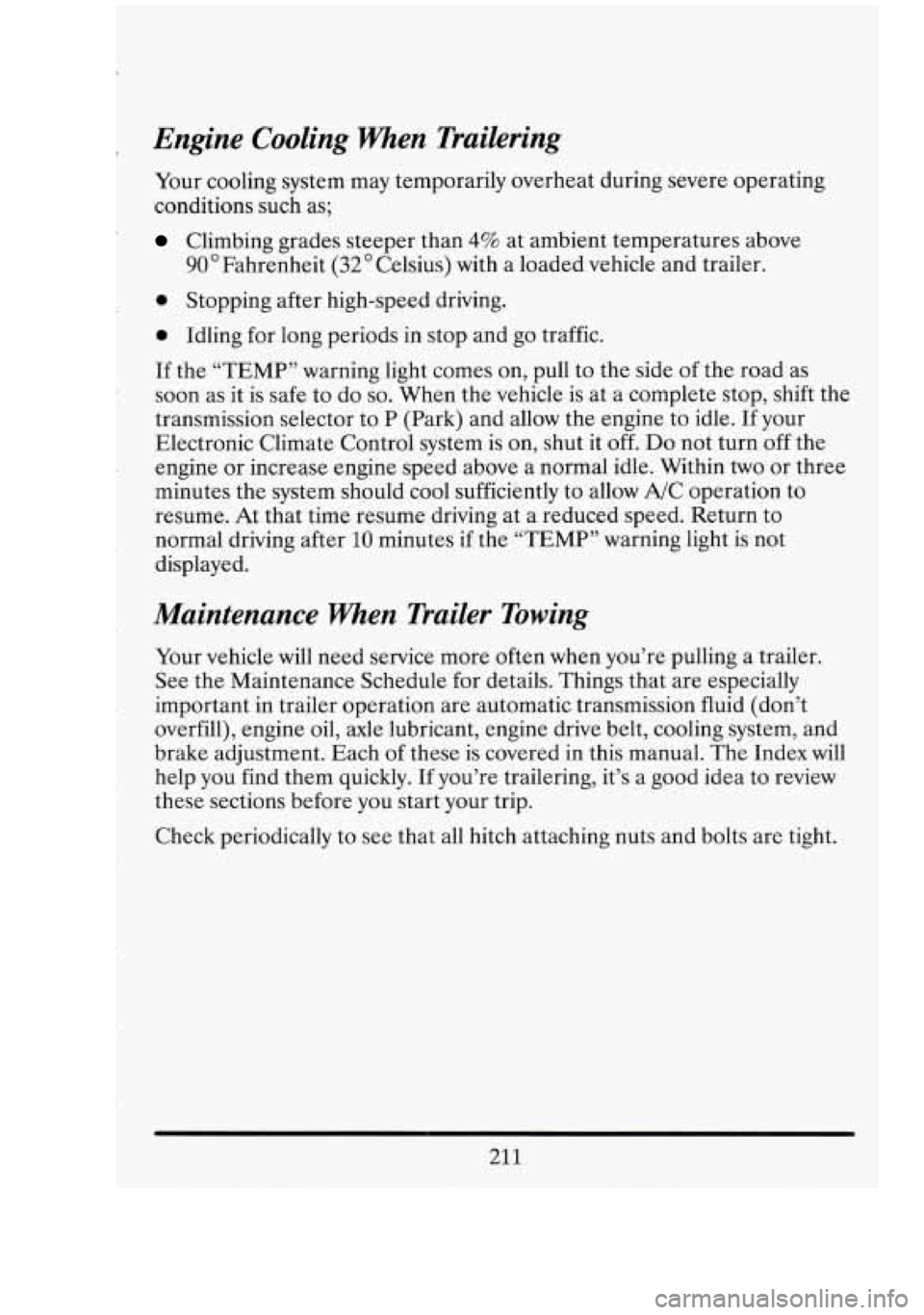
Engine Cooling When Trailering
Your cooling system may temporarily overheat during severe operating
conditions such as;
Climbing grades steeper than 4% at ambient temperatures above
90’Fahrenheit (32O Celsius)
with a loaded vehicle and trailer.
0 Stopping after high-speed driving.
0 Idling for long periods in stop and go traffic.
If the “TEMP” warning light comes on, pull
to the side of the road as
soon as it is safe to do
so. When the vehicle is at a complete stop, shift the
transmission selector to P (Park) and allow the engine to idle. If your
Electronic Climate Control system is on, shut it
off. Do not turn off the
engine or increase engine speed above a normal idle. Within
two or three
minutes the system should cool sufficiently to allow A/C operation to
resume. At that time resume driving at a reduced speed. Return to
normal driving after
10 minutes if the “TEMP” warning light is not
displayed.
Maintenance when Trailer Towing
Your vehicle will need service more often when you’re pulling a trailer.
See the Maintenance Schedule for details. Things that are especially
important in trailer operation are automatic transmission fluid (don’t
overfill), engine oil, axle lubricant, engine drive belt, cooling system, and
brake adjustment. Each of these is covered in this manual. The Index will
help you find them quickly. If you’re trailering, it’s a good idea to review
these sections before you start your trip.
Check periodically to
see that all hitch attaching nuts and bolts are tight.
21
1
Page 228 of 398

I r NOTICE:
Ignoring these steps could result in costly damage to your
vehicle that wouldn’t be covered by your warranty.
ming to start. your Cadillac by pushing or pulling it won’t
work, and
it could damage your vehicle.
TO JUMP START YOUR CXDILLAC:
1. Check the other vehicle. It must have a 12-volt battery with a negative
ground system.
NOTICE:
If the other system isn’t a 12-volt system with a negative ground,
both vehicles can be damaged.
2. Get the vehicies close enough
so the jumper cables can reach, but be
sure the vehicles aren’t touching each other. If they are, it could cause
a ground connection you don’t want. You wouldn’t be able to start
your Cadillac, and the bad grounding could damage the electrical
systems.
You could be injured
if the vehicles roll. Set the parking brake firmly
on each vehicle. Put
an automatic transmission in “P” (Park) or a
manual transmission in
“N” (Neutral).
needed, and radios. This will avoid sparks and help save both
batteries. And it could save your radio!
3. Turn off the ignition on both vehicles. Turn off all lights that aren’t
NOTICE:
If you leave your radio on, it could be badly damaged. The
repairs wouldn’t be covered
by your warranty.
215
Page 275 of 398
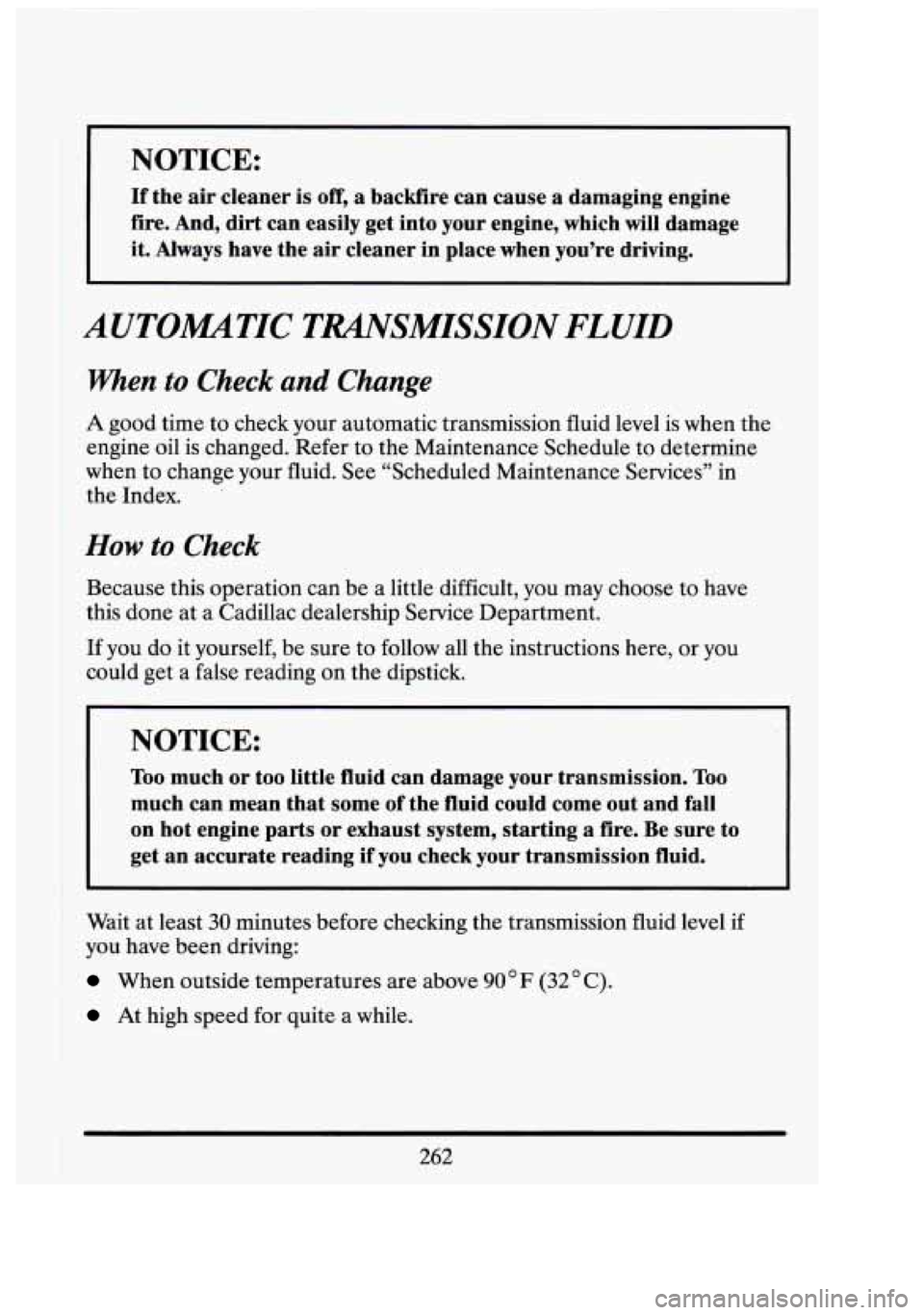
-NOTICE:
If the air cleaner is off, a backfire can cause a damaging engine
fire:And, dirt can easily get into your engine, which will damage
it. Always have the air cleaner in place when you’re driving. I
I AUTOAUTIC .TRANsIMISSION FLUID
‘When to Check and Change
A good time to check your automatic transmission fluid level is when the
engine oil is changed. Refer to the Maintenance Schedule to determine
when to change your fluid. See “Scheduled Maintenance Services” in
the Index.
How to Check
Because this operation can be a little difficult, you may choose to have
this done at .a Cadillac dealership Service Department.
If you do it yourself, be sure to follow all the instructions here, or you
cou.ld get a false reading on the dipstick.
I I Too NOTICE: much or too little fluidcan damage your. transmission. Too
much can mean that some of the fluid could come out and fall
on hot engine parts or exhaust system, starting
a fire. Be sure to
get an accurate reading
if you check your transmission fluid. i
I
Wait at least 30 minutes before checking the transmission fluid level if
you
have been driving:
When outside temperatures are above 90°F (32OC).
At high speed for. quite a while.
tll
il
3‘ I
CI)
262
Page 278 of 398
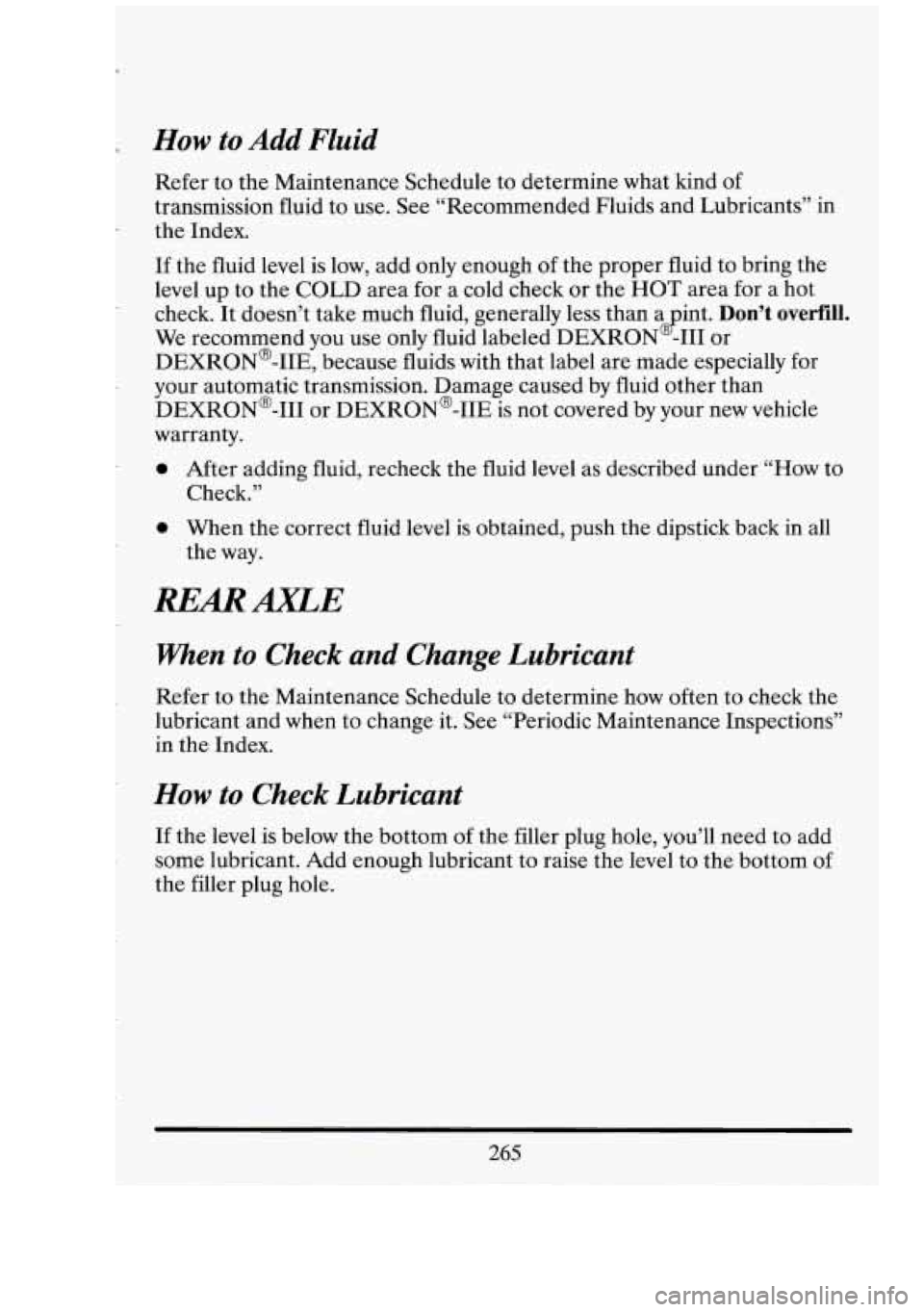
r
How to Add Fluid
Refer to the Maintenance Schedule to determine what kind of
transmission fluid to use. See “Recommended Fluids and Lubricants” in
the Index.
If the fluid level is low, add only enough of the proper fluid to bring the
level up to the COLD area for a cold check
or the HOT area for a hot
check. It doesn’t take much fluid, generally less than a int.
Don’t overfill.
We recommend you use only fluid labeled DEXRON -111 or
DEXRON@-IIE, because fluids with that label are made especially for
your automatic transmission. Damage caused by fluid other than
DEXRON@-I11 or DEXRON@-IIE is not covered by your new vehicle
warranty. 8
0 After adding fluid, recheck the fluid level as described under “HOW to
0 When the correct fluid level is obtained, push the dipstick back in all
Check.”
the way.
REARAXLE
When to Check and Change Lubricant
Refer to the Maintenance Schedule to determine how often to check the
lubricant and when to change it. See “Periodic Maintenance Inspections”
in the Index.
How to Check Lubricant
If the level is below the bottom of the filler plug hole, you’ll need to add
some lubricant. Add enough lubricant to raise the
level to the bottom of
the filler plug hole.
265
Page 380 of 398

.
.
. FLEETWOOD INDEX
.
.
.
.
.
c-
.
.
A
Acc (Ignition Key Position) ........................... 86
Adding
Brake Fluid
..................................... 274
Electrical Equipment ......................... 152. 311
Engine Coolant ............................. 227. 266
Engineoil ...................................... 256
Power Steering Fluid ............................. 271
Transmission Fluid ............................... 265
Additives. Engine Oil ............................... 260
Adjustment. Brake ................................. 178
Adult Safety Belt Usage .............................. 20
Air Bags ........................................... 30
Aircleaner ....................................... 261
Air Cleaner & PCV Filter Replace ......... See Maint . Book
Air Conditioner
.................................... 147
Air Outlets ........................................ 146
Airsystem ........................................ 146
Alarm. How To Turn Off Theft ........................ 82
Alcohol. Driving Under The Influence Of .............. 167
Alcohol& Gasoline ................................. 247
AMAX .......................................... 153
AM Radio Reception ............................... 152
AM Stereo Radio Reception ......................... 153
Antenna. Cleaning Radio ............................ 164
Antifreeze ........................................ 266
Antilock Brakes .................................... 173
Antilock Brake System Warning Light ................. 133
Anti-Theft Tips ..................................... 81
Appearance ....................................... 300
Appearance Care. Service and ........................ 245
Arm. Wearing A Safety Belt Under Your ................ 28
Armrest. Storage ................................... 129
Ashtrays .......................................... 126
Assist Handles ..................................... 128
Astroroof ......................................... 125
Audio Systems. Comfort Controls and ................. 146
Automatic Air Conditioning System ................... 147
Automatic Door Locks ............................... 71
Automatic Overdrive ................................ 92
Automatic Transmission .............................. 90
.
1